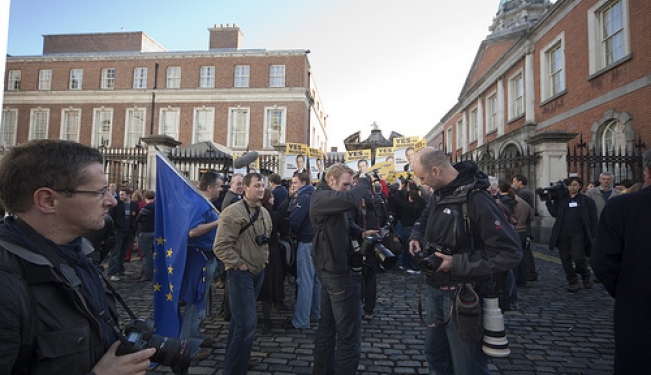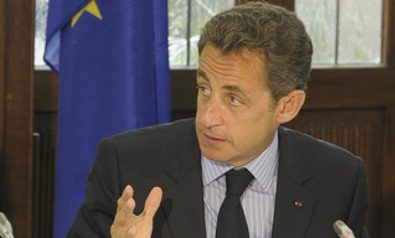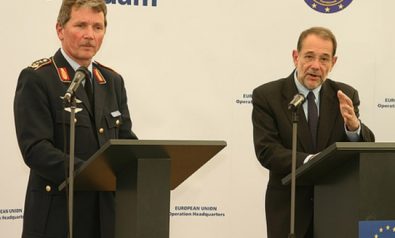A synopsis of the changing nature of Europe’s security needs, and of the evolution of Europe’s multilateral institutions to meet new security challenges.
The Treaty of Lisbon, which took effect on the 1st of December 2009, is the fruit of a long-standing ambition to streamline and make more efficient the institutions of the European Union (EU). It was by no means developed in order to confront newly perceived security issues. And yet by destiny or chance, it became the toolkit for dealing with some of the most significant changes in the European security landscape in the last decades. How will it fare on the security scorecard?
Security and defence on the road to Lisbon
European construction was from the outset, and for a large part of its development, disconnected from any matters relative to security and defence. The distant predecessors to today’s EU took the form of economic and political collaboration. A tacit distribution of responsibilities with NATO (North Atlantic Treaty Organization) developed and crystallized during the Cold War, with the military alliance operating exclusively in matters of defence and the European project focussing on matters of industrial and agricultural development. A clear trans-Atlantic division was also articulated with NATO functioning as an arm of United States foreign and security policy. In this early phase of European construction, security and defence cooperation on a European scale was hardly considered. It first entered official discussions in 1970, when the Foreign Ministers of the original six Member States formed the ‘European Political Cooperation’. The basic principles, values and ‘intergovernmental’ methods of consultation were to mark the evolution of European-level security and defence thinking up until the moment of the institutional changes brought about by the Lisbon Treaty.
The prospect of a purely European common defence was first evoked in the Maastricht Treaty in 1992 and linked institutionally to the ‘Second Pillar’ of the EU, the Common Foreign and Security Policy (CFSP). The CFSP at the time represented the ‘intergovernmental’ dimension of the EU and became the institutional setting for coordinated meeting and decision-making for Member States as states. The immaturity of the CFSP became evident by the humiliating failure of the EU to act effectively in the debacle of the Balkans. It was the United States, through the arm of NATO that engaged in military action against Serbian aggression in 1999, essentially intervening in what some would call ‘Europe’ at the moment when the EU seemed more or less completely incapable of doing so. The ambition of a coherent security and defence policy was set back considerably.
The Amsterdam Treaty of 1999 attempted to add coherence and focus to European Common Foreign Policy by creating the position of High Representative for Foreign Policy, a position held with a high degree of visibility by Javier Solana. The Amsterdam Treaty took upon itself to integrate the Western EU, (WEU) a treaty organisation tasked with enhancing political stability after the dissolution of the Soviet Union. The integration of the WEU provided a centre of gravity for further developing a fully fledged Common Foreign and Security Policy. With it, the WEU brought the important baggage of the ‘Petersberg tasks’. Adopted in 1992, these tasks set out a set of humanitarian, peacekeeping and crisis management activities that, once transferred to the Treaty of Amsterdam, formed the core of European defence activities for well over a decade. A series of such ‘missions’ marked a more modest European military and policing engagement through the 2000’s.
Innovation and challenge in the Lisbon Treaty
A number of institutional changes set the stage for the current shape of the Lisbon Treaty and constrain its options for dealing with the new security reality in Europe.
Most importantly, the Lisbon Treaty ends the 3-pillar structure of the EU. Until 2009 foreign and security policy made up one of these pillars, constituting the ‘intergovernmental’ portion of European collaboration. Lisbon transforms security policy into a ‘community’ affair. In short, it is no longer an amalgamation of 27 policies, but rather an organic, more collective unitary policy effort. This fact also paves the way for the formation of the post of High Representative for Foreign Affairs and Security Policy, currently held by Catherine Ashton, and for the creation of the European External Action Service.
The central challenge to European security and to the success of the CFSP is that the current picture, real or imagined, does not fall within the lines of the institutional measures foreseen in the Treaty.
In terms of traditional ‘hard’ defense, the Treaty of Lisbon brings several enhancements, the most important of which is a clause of ‘mutual defense’. Such a clause would have been unthinkable only a few years ago. It marks one of the strongest statements ever made of a shared European destiny and value-set. In the same vein, Lisbon also includes a ‘solidarity clause’, covering both threats and events that do not forcibly have a traditional hard security character, including natural disasters, health crises, climate change and terrorism.
The new Treaty also puts in place a revised and robust Common Foreign and Security Policy. It does not foresee the creation of a European military, but puts into place an institutional framework that could reliably support one should the politic favour such a development. For the present, any European military will remain a collaboration of willing Member States, and costs incurred during any collective European operations will be covered by the individual states involved. Finally, and remarkably, the Treaty gives a significant role to a newly formed European Defence Agency (EDA). The role of the EDA will be less one of coordinating security and defence measures than of coordinating and supporting the development of a security armaments market, one of the key elements in a global era dominated by the US industrial-security complex, in establishing a European autonomy in defence.
Finally, the Treaty of Lisbon expands the scope of such ‘soft’ security tasks of the kind earlier described as the ‘Petersberg Tasks’ and included the doctrines of the Western EU, subsequently integrated into the Treaty of Amsterdam. In this way, humanitarian operations, peacekeeping, and civilian preparedness become part and parcel of European security and defence thinking.
The new security landscape in Europe
Ironically, the most consequential and far-reaching security measures taken up in the Treaty of Lisbon do not deal with the matter of European defense understood in any classical sense, but rather with the new concepts and institutions as supports for the management of internal security.
In general terms, Europeanization has taken place against the backdrop of a new wave of globalization. The traits of this globalization are well known to us: they centre on the weakening of the sovereignty of the modern nation-state, on the development of trans-national networks and institutions, and on the global flow of information, capital and human beings. The borders of the Member States of the EU, even well-before the EU became an institutional reality, have become increasingly porous or even blurred. In the early phases of European construction, globalization was approached through economic measures in response to global economic changes. European construction in the early days was practiced as a dismantling of institutional inconsistencies between the economic systems of the Member States. The mantra of the free movement of goods, services and capital, which remains alive and well today, led to a gradual dismantling of the EU’s internal borders. It also led to the emergence and generalisation of a kind of European political sovereignty. Institutionally, this has meant confronting the challenge of harmonising the institutions of governance that have traditionally given form to inter-national relations in Europe.
This Europeanization-as-globalization process has also brought significant changes to the present threat landscape. A wide range of security threats, both new and traditional, confront states, individuals and societies. New forms of nationalism, ethnic conflict and civil war, information technology, biological and chemical warfare, resource conflicts, pandemics, mass migrations, transnational terrorism, and environmental dangers challenge the conventional means of understanding threats and of assuring the security of all regions of the world. What is more, a growing awareness of these new threats is challenging the way in which the principles and tasks of security scholarship are presently understood. No one state can manage the array of threats to its own security, nor can any one state manage the threats to the security of its neighbours both inside and outside Europe. In the globalized setting the challenge of maintaining security is no longer limited to the traditional foreign-policy and military tools of the European member states.
In this context the issue with the most significant consequences for security policy in Europe has been the problem of migration. Migratory flows have changed significantly in the last decades; and an enhanced awareness of the migration of both European citizens and foreigners, within and toward Europe, has had growing political consequences. The spectre of transnational terrorism has only amplified this effect. The perceived threat of migration is the centre of a new constellation of ‘soft’ threats, which not only challenge the European conscience of the dangers with which it coexists, but also calls into question the traditional security and defence arrangements based on ‘hard’ threats challenging distinct national borders. This new landscape of security no longer maps easily onto the geopolitical borders of the nation-state and the EU.
The new threats traverse and resist the institutional ‘borders’ and arrangements traditionally designed to manage them (social agencies, informational authorities, police, etc.) The most significant effect of this shift is that the lives of citizens are no longer regulated at the physical borders. The border operations traditionally provided for by the nation-state (border controls and security guards, passport authorities, etc.) have been shifted outward and a growing number of European and international organisations have taken on increasingly dominant roles entirely detached from nation-state sovereignty. This shift in the responsibilities of international organizations further contributes to the interrelatedness of non-national institutions and regions, weakening both the role and capacity of traditional sovereignty arrangements.
Cross-border challenges to CFSP implementation
The new Common Foreign and Security Policy (CFSP), child of the Lisbon Treaty, transforms the conceptual baggage of the national security and defence model that has dominated security thinking in Europe for a century. Traditionally, foreign policy and defence and security strategy have constituted the security and defence strategy to the external threat profile. In this perspective the threat of terrorism, even in its earlier 20th century European forms, was a matter for home affairs. The perception supporting that attitude changed significantly with the attacks of 11 September 2001, and was then further confused with the Madrid bombings on 11 March 2004 and the London bombings of 11 July 2005. The threats to internal security then began to intermingle, and flow into and enhance the threats to the external security. This led to an intensified reflection on the nature of threat to Europe and set in motion a number of important political activities with the aim of securing the EU against terrorism. Here, though the terrorist threat to Europe concerns primarily the lives of Europeans on EU territory, the link to external threats becomes immediately evident.
The most recent and most significant evolution in the European security reality is the gradual detachment and shifting of the internal and external security borders from the national and European physical borders. As we have seen, this shift has had two main effects. First, it has brought about the fulfilment of a central ambition of the European project, shifting the legitimacy and functionality of security services to the European level. This has enhanced and rationalized in a number of ways the assurance of security in the EU. Secondly, it has created synergies, collaborations, and constellations in the European security architecture that were not foreseen by even the most recent visionaries of the European project. The technological impulse so prominently guiding European security thinking today will not realise its potential without the insight that the threat to Europe is a threat to its values, and that those values, fluid and amorphous as they are, are not objects.
Fragmented security culture for a unified security strategy?
The greatest irony of recent efforts to build, harmonise and streamline a security and defence strategy for Europe is that the highest level of harmonisation in the institutions corresponds with the historically highest level of fragmentation of the security landscape. If we look closely, we see that the values at heart of European identity in general, and threats to that identity, in particular, are not stable, timeless and universal. Our security culture changes them, even reproduces, and reshapes them.
The nature of the European project calls for the recognition of a multiplicity of European cultures and thereby a multiplicity of experiences of threat. In many ways, the Internal Security Strategy constitutes a set of measures forming an Europeanization of internal security of the kind we have seen on the political, economic and cultural level: transferring activities, authorities and competencies from the national to the European level. One might ask, in this case, whether the Europeanization of security in Europe, can take place in the same way as the Europeanization of other traditional nation-state ways-of-life and the security cultures they imply. The European threat landscape is highly uneven and fragmented. That which is an insecurity for one European is not necessarily so for another.
As a response to this fragmentation, the Internal Security Strategy, released in 2010, aims to bring under one ‘roof’ a standardised and unified set of measures for managing internal security in Europe, and to bring it under the purview of one regulatory authority, the COSI (Standing Committee on Operational Cooperation and Internal Security). While few of the individual measures are actually new, the novelty of the document is its coordination, centralisation and standardisation. Such a heavily unified security architecture as it is proposed by the Internal Security Strategy may simply be too much for a fragmented European house.
The same can be said for the landscape of security-relevant values, which are becoming the core justification for increasingly enhanced security measures. The ‘common values’ at the heart of the Internal Security Strategy, not to speak of the Lisbon Treaty, are not common in a way that would form the basis for unified security culture. Despite its commonalities, the richness of Europe’s reality lies in its varying cultural values. While there will obviously be basic consensus on the ‘headline values’ of democracy, rule of law, freedom of expression,, these are experienced—and threatened—in many different ways in Europe.
In conclusion, many things fragment Europe: culture, language, religion, economics, politics, etc. The most new and remarkable force of fragmentation of the EU is security itself. The attempts to find a unified security model, like the Internal Security Strategy, will likely collide on the ground level with this reality: the background for a tightly unified institutional approach to security in Europe is a fragmented experience of threats, values, security and insecurity. This is the reality of Europe’s new security culture.
The management of insecurities through technology and the development of new technologies for security is increasingly becoming a policy priority for the EU and its Member states. This new emphasis on technological responses to insecurity is justified in governmental arenas through the argument that this drive is rendered necessary by the environment of new global threats of the post-bipolar era. The novelty of this environment, it is claimed, lies in the trans-national and asymmetric dimension of danger, and thus, in its unpredictability as compared to the previous period. Threatening developments, in this perspective, range from trans-national organized crime to illegal migrations, and include various forms of political violence including new forms of warfare. New technologies of control and surveillance, which rely in particular on evolutions in communication and information technologies, are in this perspective deemed crucial, because they supposedly permit one to move beyond reactive measures, developing the capacities of security agencies to anticipate threats and act proactively.
Support Fair Observer
We rely on your support for our independence, diversity and quality.
For more than 10 years, Fair Observer has been free, fair and independent. No billionaire owns us, no advertisers control us. We are a reader-supported nonprofit. Unlike many other publications, we keep our content free for readers regardless of where they live or whether they can afford to pay. We have no paywalls and no ads.
In the post-truth era of fake news, echo chambers and filter bubbles, we publish a plurality of perspectives from around the world. Anyone can publish with us, but everyone goes through a rigorous editorial process. So, you get fact-checked, well-reasoned content instead of noise.
We publish 2,500+ voices from 90+ countries. We also conduct education and training programs
on subjects ranging from digital media and journalism to writing and critical thinking. This
doesn’t come cheap. Servers, editors, trainers and web developers cost
money.
Please consider supporting us on a regular basis as a recurring donor or a
sustaining member.
Will you support FO’s journalism?
We rely on your support for our independence, diversity and quality.












Comment